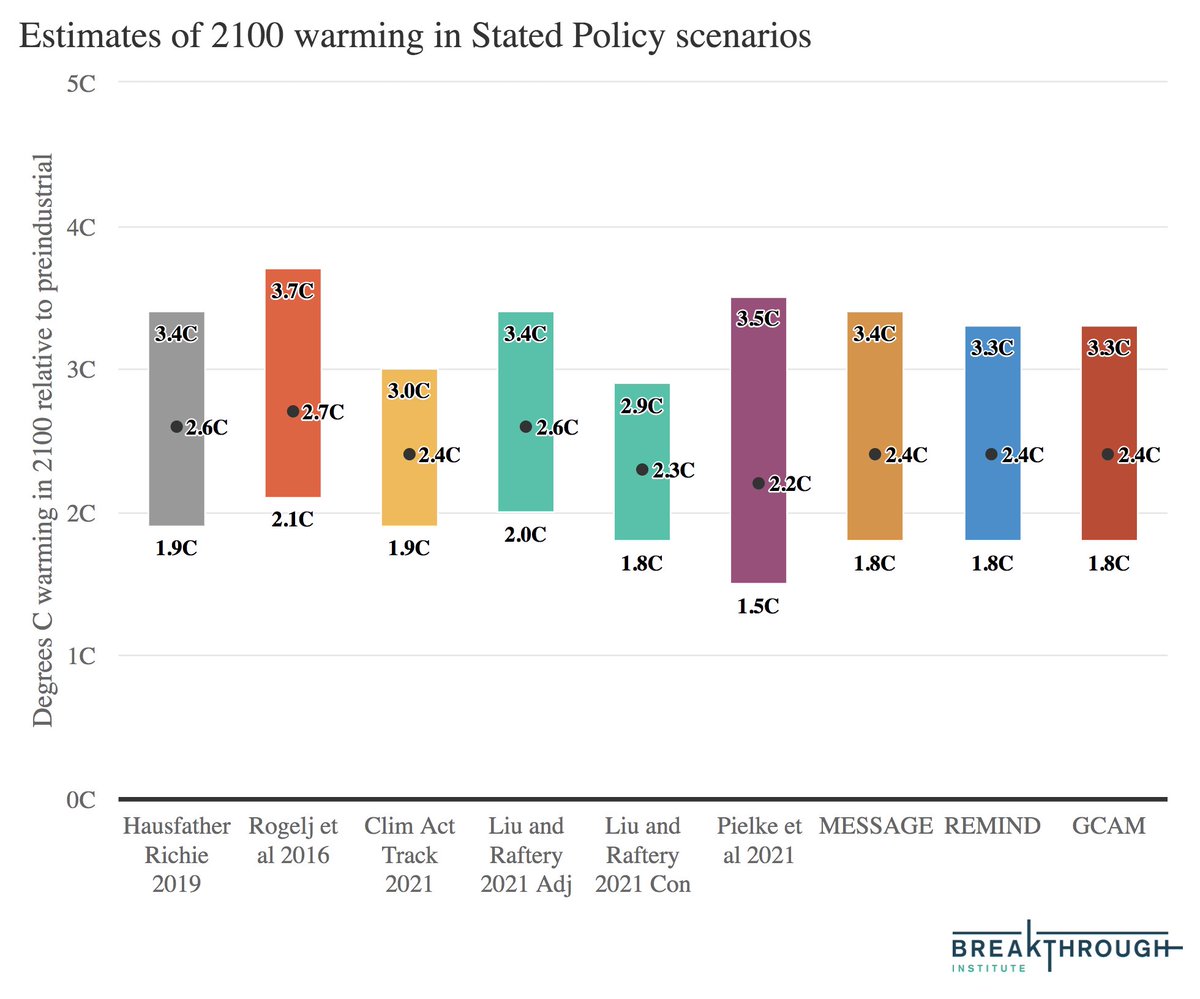
There's grim news in the IPCC report, but also reasons for hope. We're flattening the curve of future emissions, and the darkest climate futures a decade ago are much less likely now. We can both celebrate progress and acknowledge how far we have to go: thebreakthrough.org/issues/energy/… 1/ 

A decade ago the world seemed on track for a particularly grim climate future. China was building a new coal plant every three days; global emissions were increasing at a rate of 3% per year and increased by 31% between 2001 and 2010. 2/
Scenarios where global carbon emissions tripled by the end of the 21st century with coal use increasing sixfold seemed plausible to many. Researchers argued that “business as usual” would likely lead to a world 4ºC or 5ºC above pre-industrial levels by 2100. 3/
Today, the world is a different place. We're succeeding in making clean energy cheap, with solar power and battery storage costs falling 10-fold since 2009. The world produced more electricity from clean energy – solar, wind, hydro, and nuclear – than coal over past two years. 4/
The International Energy Agency (IEA) now argues global coal use is in structural decline, unlikely to ever surpass its 2013 peak, while the odds of a 21st century dominated by coal now seem vanishingly small. 5/
These energy system change matter; a sizable number of studies now suggest that the world is on track for around 3C warming by 2100 under current policies. This includes the very same IAMs (MESSAGE and REMIND) used to create to high-end RCP8.5 and SSP5-8.5 baseline scenarios. 6/ 

If countries achieve their short-term (2030) Paris NDC commitments (e.g. stated policies), the best estimate of future warming is 2.4C by 2100. There is a wider spread of estimates here, as what is "stated policy" can be a bit fuzzy at times. 7/ 

The past decade has been characterized by strengthening climate policy and rapid declines in clean energy costs, and these trends appear likely to continue. A stated policy world is probably a more likely outcome from the vantage of the present than a current policy world. 8/
At the same time, the future is deeply uncertain. We cannot rule out a world where some current policies are rolled back, where countries directly subsidize coal consumption as Trump unsuccessfully attempted to do. Current and stated policies are neither a ceiling nor a floor. 9/
If emissions alone determined warming, we would likely end up somewhere around 3ºC by 2100 in a current policy world, and 2.4ºC in a stated policy world. However, emissions one of three major uncertainties; the other two are climate sensitivity and carbon cycle feedbacks. 10/
We still cannot rule out warming of as much as 5C in a current policy world, or up to 4C in a stated policy world. These are not the most likely outcomes, of course, but remain a risk should we get unlucky with both high climate sensitivity and high carbon cycle feedbacks. 11/ 

Even 3C by 2100 is decidedly not a world we want to live in, with substantial impacts on both human and natural systems. And uncertainty is decidedly not our friend; even if we were willing to accept risks of 2.5C or 3C warming. 12/
The “tail risks” of substantially higher outcomes provide an important motivation to further mitigate emissions. There is a danger of being too deterministic around likely warming outcomes of our emissions if we do not properly account for other climate system uncertainties. 13/
Carbon dioxide accumulates in the atmosphere over time, and until emissions reach net-zero the world will continue to warm. This is the brutal math of climate change, and it means that the full decarbonization of our economy is not a matter of if but when. 14/
This means that even if our estimate of 2100 warming is 3C (2C to 5C) under current policies and 2.4C (1.7C to 4C) under stated policies, the world will continue to warm after that point as these emission pathways do not get us to net-zero. 15/
The world has made real progress toward bending down the curve of future emissions. The worst-case outcomes of a decade ago are much less plausible today. At the same time, we have a long way to go if we want to meet Paris Agreement goals of well below 2C. 16/
We can both acknowledge progress we've made and how far we still have to go. The justification for limiting warming to well-below-2C never required having a 5C counterfactual, and it is important that we acknowledge where we are headed today rather than what might have been. 17/
For more details, see my longer analysis over at Breakthrough: thebreakthrough.org/issues/energy/… 18/18
• • •
Missing some Tweet in this thread? You can try to
force a refresh





